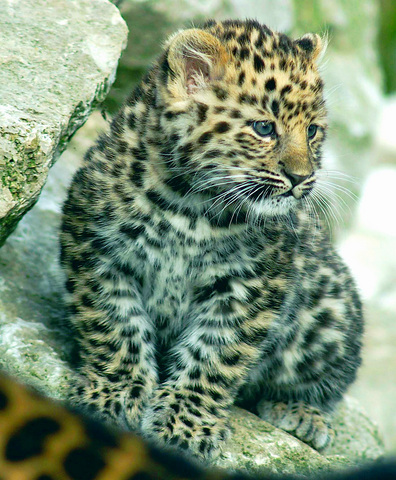China's state apparatus believes the country's pandas must be saved at all costs. Sri Lanka pays fishermen to protect rare sea turtles. And the Dominican Republic has a parrot team dedicated to saving the Sisserou parrot.
All over the world, governments strive to preserve "flagship species" that are pushed into service as symbols of national pride. So why is Russia building a US$12 billion oil pipeline through the habitat of the world's rarest big cat?
With its long, slender legs and shaggy coat, the Amur leopard is a predator that stalks the frozen forests of far eastern Russia.

PHOTO: EPA
Naturalists say its beauty and endangered status -- there are only 30 or 40 left in the wild -- make it an ideal candidate to be a flagship.
But Moscow seems deaf to environmentalists' protests that a trans-Siberian oil pipeline planned to run straight through the leopards' last wild haven could wipe them out.
The 3,000km pipeline, intended to supply oil to Japan, was to have run from the tip of Lake Baikal to the Pacific port of Nakhodka.
But an abrupt announcement late last year made clear that a minor diversion would take the route straight through the leopards' habitat.
Campaigners in Vladivostok say the decision by the state-owned pipeline monopoly, Transneft, is "catastrophic."
Construction begins soon and the pipeline will pass through the border zone of the Unesco-designated Kedrovaya Pad biosphere reserve on the Pacific coast, where the cats live, at a pristine bay near Vladivostok, called Perevoznaya. Cynics have speculated that local politicians in the East, who approved the route, have snapped up land near the bay and aim to benefit from contracts for construction of an oil terminal and port services funded by Japanese soft loans.
"Like a lot of Russia's ambitious projects, this pipeline plan is largely motivated by bureaucrats who are sure of a slice of the profits," says Alexei Yaroshenko, of Greenpeace in Moscow.
Sergei Darkin, governor of Primorye, the territory where the leopards live, denies accusations that he could benefit from kickbacks if construction contracts go to his associates.
The plight of the leopards is being seen as a test case for Russia, where the environment is often trampled in a rush for commercial profit.
Opponents say the pipeline will not only disrupt the leopards but tear through a unique ecosystem that supports rare and endangered species. Kedrovaya Pad is a richly forested valley home to Chinese sparrowhawks and Hodgson's hawk eagles.
While the Western end of the pipeline may not be finished for several years, a new railway to carry oil along the same route will cause equal destruction until it is completed. "All the disturbance -- the smells, the machinery, the swathe cut through their woodland -- will drive the leopards out of their habitat," says Vitaly Gorokhov, head of Ecoyuris, a group of lawyers fighting the plans.
The Amur leopard is the northernmost of the eight leopard sub- species, and lives only in a small corner of the Far East near the Sino-Russian border. It feeds on roe and sika deer, as well as hares and badgers. There are about 100 of the leopards in captivity for breeding purposes, but Kedrovaya Pad is their last wild habitat.
Experts say that, if driven away, the leopards will be forced into terrain where there is no prey to feed on, or towards densely populated areas of China, where the animals are hunted for use in medicines.
Transneft appears unrepentant. Challenged this spring, Transneft president Simyon Vainshtok said, "We are willing to start a dialogue with all stakeholders. We will talk to every leopard and shrimp in the bay."
Yet Transneft has refused to publish an environmental impact assessment and gives every sign of pushing ahead with the project. Ecologists say the fact that a pipeline is even being considered demonstrates how far Russia is willing to milk its natural resources for profit. Priorities in Primorye became clear when the regional hunting inspectorate approved the Perevoznya route.
"The inspectorate is entitled to financial compensation for the ecological damage caused by disrupting the leopards," says Gorokhov, of Ecoyuris. The damage was calculated according to the estimated sale value of the cats' skins.
"Of course it was better to have US$100,000 in their hands right now than to have a bunch of leopards alive in 10 years' time," said Gorokhov. "That's how nature conservation works in Russia."
Activists in the East believe that they can still force a change in the route. Transneft's plans have attracted prominent critics, including the president of the Russian Academy of Sciences, Yuri Osipov, and President Putin's chief of staff, Dmitry Medvedev.
He wrote to prime minister Mikhail Fradkov suggesting that the pipeline should stick to the original route.
Sarah Christie, of the London Zoological Society, who coordinates an Amur leopard breeding program, said there was still time to pull back from the brink. "We don't oppose Russia developing its natural resources," she said. "We are just against this disastrous choice of terminal location."

Taiwanese chip-making giant Taiwan Semiconductor Manufacturing Co (TSMC) plans to invest a whopping US$100 billion in the US, after US President Donald Trump threatened to slap tariffs on overseas-made chips. TSMC is the world’s biggest maker of the critical technology that has become the lifeblood of the global economy. This week’s announcement takes the total amount TSMC has pledged to invest in the US to US$165 billion, which the company says is the “largest single foreign direct investment in US history.” It follows Trump’s accusations that Taiwan stole the US chip industry and his threats to impose tariffs of up to 100 percent

On a hillside overlooking Taichung are the remains of a village that never was. Half-formed houses abandoned by investors are slowly succumbing to the elements. Empty, save for the occasional explorer. Taiwan is full of these places. Factories, malls, hospitals, amusement parks, breweries, housing — all facing an unplanned but inevitable obsolescence. Urbex, short for urban exploration, is the practice of exploring and often photographing abandoned and derelict buildings. Many urban explorers choose not to disclose the locations of the sites, as a way of preserving the structures and preventing vandalism or looting. For artist and professor at NTNU and Taipei

In the run-up to World War II, Admiral Wilhelm Canaris, head of Abwehr, Nazi Germany’s military intelligence service, began to fear that Hitler would launch a war Germany could not win. Deeply disappointed by the sell-out of the Munich Agreement in 1938, Canaris conducted several clandestine operations that were aimed at getting the UK to wake up, invest in defense and actively support the nations Hitler planned to invade. For example, the “Dutch war scare” of January 1939 saw fake intelligence leaked to the British that suggested that Germany was planning to invade the Netherlands in February and acquire airfields

The launch of DeepSeek-R1 AI by Hangzhou-based High-Flyer and subsequent impact reveals a lot about the state of the People’s Republic of China (PRC) today, both good and bad. It touches on the state of Chinese technology, innovation, intellectual property theft, sanctions busting smuggling, propaganda, geopolitics and as with everything in China, the power politics of the Chinese Communist Party (CCP). PLEASING XI JINPING DeepSeek’s creation is almost certainly no accident. In 2015 CCP Secretary General Xi Jinping (習近平) launched his Made in China 2025 program intended to move China away from low-end manufacturing into an innovative technological powerhouse, with Artificial Intelligence